3M Scott Technologies 201160 X3 Pak Alert SE7 User Manual 595277 01 A
Scott Safety-Division of Scott Technologies, Inc. X3 Pak Alert SE7 595277 01 A
User Manual
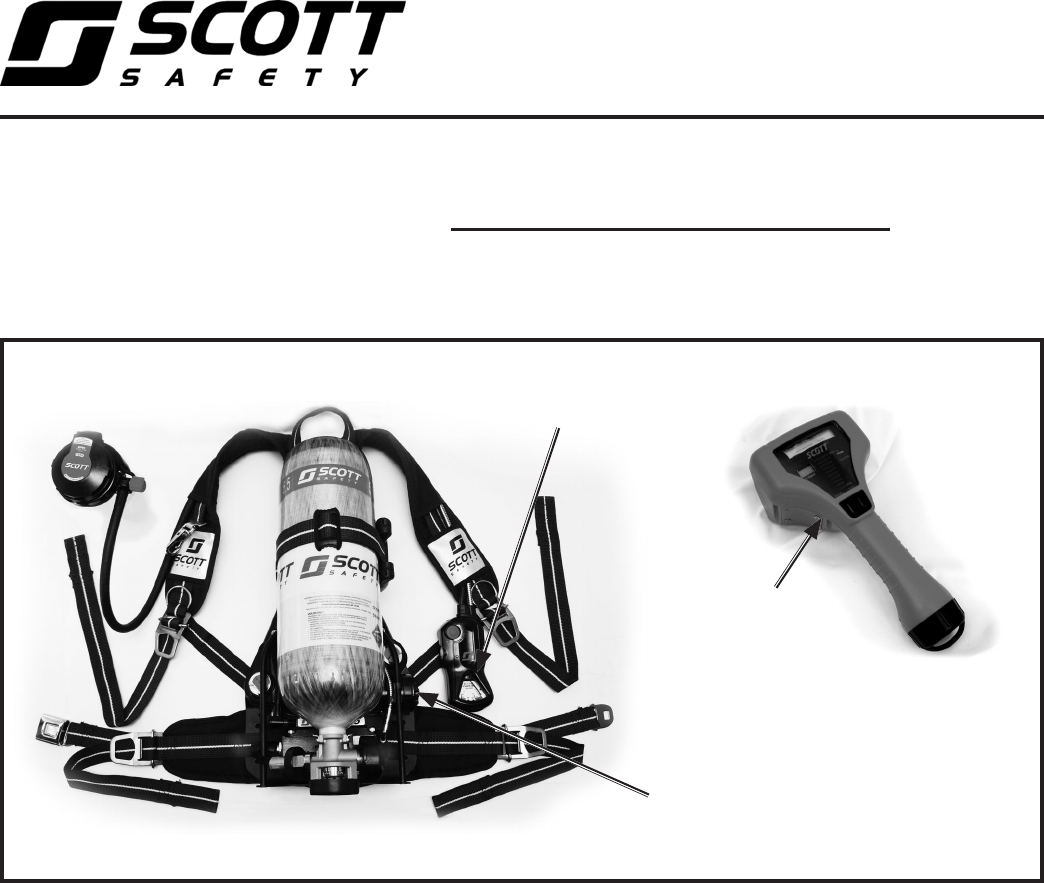
Page 1 of 28 P/N 595277-01 Rev E 10/17
THE SCOTT PAK-ALERT DISTRESS ALARM
INCLUDING THE OPTIONAL SCOTT PAK-TRACKER LOCATOR SYSTEM
INTEGRATED WITH THE SCOTT AIR-PAK X3 & X3 PRO CGA OR SNAP-CHANGE
SELF-CONTAINED BREATHING APPARATUS (SCBA)
FIGURE 1
AIR-PAK X3 SCBA WITH PAK-TRACKER LOCATOR TRANSMITTER
SPECIALLY EQUIPPED PAK-ALERT DISTRESS ALARM ASSEMBLY
PAK-ALERT
CONTROL CONSOLE ASSEMBLY
SENSOR MODULE ASSEMBLY
WITH OPTIONAL PAK-TRACKER
LOCATOR TRANSMITTER
(RED LABELS)
OPTIONAL
PAK-TRACKER
HAND HELD
RECEIVER
© 2017 Scott Safety. SCOTT, the SCOTT SAFETY Logo, Scott Health and Safety, PAK-ALERT, AIR-PAK, X3, SNAP-
CHANGE, VIBRALERT, and PAK-TRACKER are registered and/or unregistered marks of Scott Technologies, Inc. or
its afliates.
OPERATION AND MAINTENANCE INSTRUCTIONS
DRAFT
NOT FOR DISTRIBUTION
Page 2 of 28
P/N 595277-01 Rev E 10/17
DRAFT
NOT FOR DISTRIBUTION
Page 3 of 28 P/N 595277-01 Rev E 10/17
TABLE OF CONTENTS
DESCRIPTION ........................................................................................................ 5
PAK-ALERT DISTRESS ALARM ............................................................................5
OPTIONAL PAK-TRACKER LOCATOR SYSTEM .................................................5
SAFETY LISTINGS .................................................................................. 7
FCC COMPLIANCE ................................................................................................. 7
CLASS B DIGITAL DEVICE ....................................................................................7
INDUSTRY CANADA COMPLIANCE .....................................................................7
RADIO FREQUENCY INTERFERENCE (RFI) ........................................................8
INTRINSICALLY SAFE LISTING .............................................................................8
OPERATION OF THE SCOTT PAK-ALERT DISTRESS ALARM .......................... 9
PRE-ALARM ............................................................................................................ 10
FULL ALARM ..........................................................................................................10
MANUAL ALARM ....................................................................................................10
TO TURN OFF THE PAK-ALERT DISTRESS ALARM ...........................................11
LOW BATTERY .......................................................................................................11
BATTERY TEST .......................................................................................................11
USE OF THE OPTIONAL SCOTT PAK-TRACKER LOCATOR SYSTEM ... 12
USE AS PART OF AN ACCOUNTABILITY SYSTEM .............................................12
PRINCIPLES OF OPERATION OF THE PAK-TRACKER LOCATOR SYSTEM ....12
DETECTING AND AVOIDING ................................................................................ 13
RADIO FREQUENCY INTERFERENCE ................................................................ 13
RFI AND THE PAK-TRACKER HAND HELD RECEIVER ......................................14
INSPECTION OF A PAK-ALERT DISTRESS ALARM ............................................ 15
INSPECTION OF A PAK-ALERT DISTRESS ALARM WITH OPTIONAL ..............
PAK-TRACKER LOCATOR SYSTEM ...........................................................17
OPERATION OF SENSOR MODULE LIGHTS .......................................................20
BATTERY REPLACEMENT .................................................................................... 23
DRAFT
NOT FOR DISTRIBUTION
Page 4 of 28
P/N 595277-01 Rev E 10/17
DRAFT
NOT FOR DISTRIBUTION
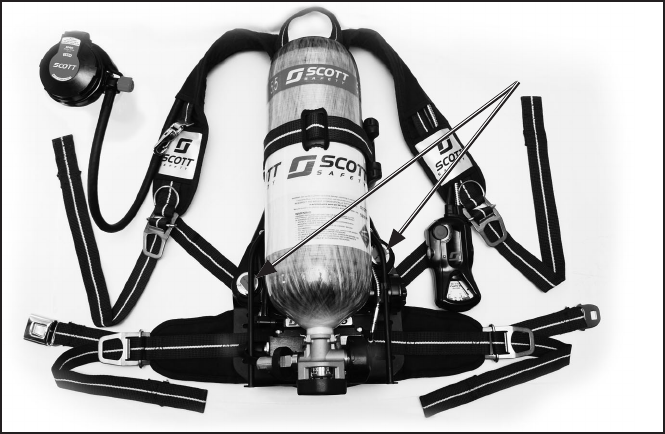
Page 5 of 28 P/N 595277-01 Rev E 10/17
OPTIONAL PAK-TRACKER LOCATOR SYSTEM
This unit may also be equipped with the optional SCOTT PAK-TRACKER
Locator System as identied by the two round RED "PAK-TRACKER" labels
on the Sensor Module. See FIGURE 2.
1 Kevlar is a registered trademark of E. I. Du Pont
de Nemours, Inc.
WARNING
NO PERSONAL ALERT SAFETY SYSTEM,
RESPIRATOR OR COMBINATION OF PERSONAL
ALERT SAFETY SYSTEM AND RESPIRATOR,
BY THEMSELVES, CAN PROVIDE COMPLETE
PROTECTION IN FIRE SITUATIONS. HOWEVER,
USING AN ALARM AND A RESPIRATOR IN
ACCORDANCE WITH THE REQUIREMENTS OF
AN ORGANIZED RESPIRATORY PROTECTION
PROGRAM IS ONE OF THE MANY SAFETY
PRECAUTIONS WHICH SHOULD BE TAKEN TO
AVOID PERSONAL INJURY OR DEATH.
WARNING
USERS OF RESPIRATORS EQUIPPED WITH THE
PAK-ALERT DISTRESS ALARM MUST BE AWARE
OF THE PROPER OPERATION OF THE DISTRESS
ALARM. IF THE GREEN LIGHT IS NOT FLASHING
NORMALLY, OR IF THE UNIT EXHIBITS ANY
OTHER SIGNS OF A MALFUNCTION WITHOUT
THE USER TAKING PROPER CORRECTIVE
ACTION, IT MAY LEAD TO CIRCUMSTANCES
THAT RESULT IN SERIOUS INJURY OR DEATH.
WARNING
DO NOT OPERATE THIS EQUIPMENT WHILE
UNDER THE INFLUENCE OF DRUGS, ALCOHOL,
OR ANY MEDICATIONS OR SUBSTANCES
WHICH MAY AFFECT VISION, DEXTERITY, OR
JUDGMENT. USERS OF THIS EQUIPMENT MUST
BE IN GOOD PHYSICAL AND MENTAL HEALTH
IN ORDER TO OPERATE SAFELY. DO NOT USE
THIS EQUIPMENT WHEN FATIGUE PREVENTS
SAFE OPERATION. STAY ALERT WHEN
OPERATING THIS EQUIPMENT. INATTENTION
OR CARELESSNESS WHILE OPERATING THIS
EQUIPMENT MAY RESULT IN SERIOUS INJURY
OR DEATH.
FIGURE 2
PAK-TRACKER EQUIPPED RED LABELS ON SENSOR MODULE
PAK-TRACKER EQUIPPED
RED LABELS
ON SENSOR MODULE
PAK-ALERT DISTRESS ALARM
The SCOTT PAK-ALERT distress alarm consists of a Sensor Module mounted
to the bottom of the respirator backframe and a control console mounted on
the wearer’s right shoulder strap at the pressure gauge location. The SCOTT
PAK-ALERT distress alarm reaches full alarm in a total of thirty (30) seconds
after detecting that the respirator user is motionless. The alarm may also be
activated manually.
The SCOTT PAK-ALERT distress alarm is approved by the National Institute
of Occupational Safety and Health (NIOSH) on all models of SCOTT SCBA
except as specied in the limitations of use on the SCBA approval label and in
the SCBA Operating and Maintenance Instructions. The PAK-ALERT distress
alarm is approved under NFPA 1982, 2013 edition as a PASS device when
used on an approved SCOTT respirator.
NIOSH certied SCBA’s are limited to a maximum weight of 35 lbs. When the
PAK-ALERT distress alarm is used with a one hour duration SCOTT SCBA,
either the Kevlar1 wrapped (SCOTT P/N 804222-01) or Carbon wrapped
(P/N 804723-XX) cylinder and valve assembly must be used to keep the total
weight under 35 lbs. limit. Using the PAK-ALERT distress alarm with berglass
wrapped one hour cylinder and valve assemblies, (SCOTT P/N 804107-01
or P/N 802827-01), will exceed 35 lbs.
Installation of a SCOTT PAK-ALERT distress alarm on a SCOTT AIR-PAK
SCBA requires some disassembly of the respirator. Installation instructions
are included with the eld installation kit available from your SCOTT distribu-
tor or from SCOTT SAFETY.
The PAK-ALERT distress alarm is a PERSONAL ALERT SAFETY SYSTEM
(PASS) intended to assist in locating a respirator user who is incapacitated
or in need of assistance. The SCOTT PAK-ALERT distress alarm, P/N
201160-SERIES, is an optional accessory intended only for use on SCOTT
SCBA respirators including the AIR-PAK X3 CGA and AIR-PAK X3 SNAP
CHANGE Self-Contained Breathing Apparatus (SCBA). This line of electronic
accessories is for use by re ghters, rst responders, domestic preparedness
and law enforcement ofcers, as well as industrial and hazardous material
users.
DESCRIPTION
CAUTION
DO NOT USE A FIBERGLASS WRAPPED ONE
HOUR CYLINDER ON A MODEL 4.5 AIR-PAK
EQUIPPED WITH A PAK-ALERT DISTRESS
ALARM AS THE WEIGHT WILL EXCEED
THE 35 LBS APPROVAL LIMIT FOR SCBA’S
ESTABLISHED BY NIOSH.
DRAFT
NOT FOR DISTRIBUTION
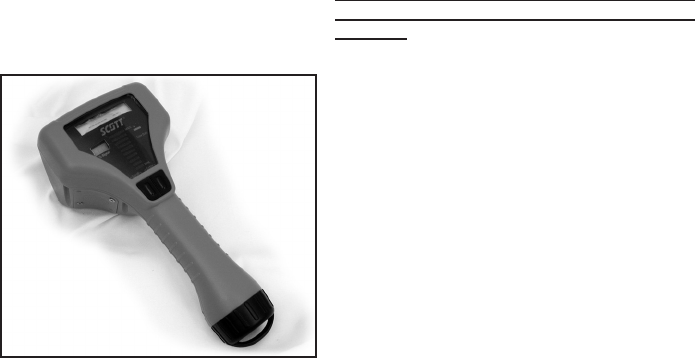
Page 6 of 28
P/N 595277-01 Rev E 10/17
WARNING
READ AND UNDERSTAND THIS ENTIRE MANUAL
AND THE PAK-TRACKER LOCATOR SYSTEM
MANUAL. TRAINING IS REQUIRED BEFORE
USE OF THIS EQUIPMENT IN A HAZARDOUS
SITUATION. THE TRAINING MUST INCLUDE
AN UNDERSTANDING OF THE LIMITATIONS
OF THE EQUIPMENT AND HOW TO INTERPRET
LOCATING INFORMATION, ALONG WITH
EXTENSIVE PRACTICE WITH THE SYSTEM
IN A VARIETY OF ENVIRONMENTS. USE
OF THIS EQUIPMENT MUST A PART OF A
COMPLETE PERSONNEL ACCOUNTABILITY
SYSTEM. ALWAYS UPDATE TRAINING WITH
EACH NEW PIECE OF EQUIPMENT. USE OF A
PAK-TRACKER LOCATOR SYSTEM WITHOUT
PROPER TRAINING MAY PLACE THE USERS
AT HIGHER RISK IN DANGEROUS SITUATIONS
WHICH COULD RESULT IN SERIOUS INJURY
OR DEATH.
The SCOTT PAK-TRACKER Locator System is a two part electronic system
consisting of a PAK-TRACKER Transmitter integrated into the SCOTT PAK-
ALERT distress alarm, and a PAK-TRACKER Hand Held Receiver, which is a
directional receiver used to locate the signal coming from the PAK-TRACKER
Transmitter. The PAK-TRACKER locator system transmitter is activated with
the PASS alarm. The transmitter emits a radio signal with a unique ID number
that can be tracked using the SCOTT PAK-TRACKER Hand Held Receiver unit.
The PAK-TRACKER Hand Held Receiver is then used as a directional receiver
personnel accountability system that includes procedures for monitoring the
deployment and condition of all users. Do not rely on the PAK-TRACKER
Locator System as the only technique for locating missing personnel. Fail-
ure to use this equipment properly may actually increase the time needed
to locate and rescue personnel. TRAINING AND PRACTICE IN REALISTIC
EMERGENCY SIMULATIONS IS REQUIRED BEFORE USE OF THIS EQUIP-
MENT. The users must become thoroughly familiar with the operation and
the limitations of the locator system before entering a potentially hazardous
or life threatening situation.
The PAK-TRACKER Locator System User Instructions contain essential in-
formation on the use of the locator system and must be used as the basis of
training for use of the whole system including use with a PAK-ALERT distress
alarm equipped with the PAK-TRACKER Transmitter. The PAK-TRACKER
Locator System User Instructions include an overview of the system opera-
tion, limitations of the system, as well as any user level maintenance for the
PAK-TRACKER Locator System equipment. Copies of the PAK-TRACKER
Locator System User Instructions are available from your SCOTT distributor
or from SCOTT Safety.
to assist in leading the rescue team to
the activated transmitter. By pointing
the PAK-TRACKER Hand Held Re-
ceiver in the direction of the strongest
relative signal, the rescue crew can
follow the signal toward the respirator
user who is incapacitated or in need
of assistance.
Use of the PAK-TRACKER Locator
System must be part of a complete
FIGURE 3
PAK-TRACKER
HAND HELD RECEIVER
DATA LOGGING FEATURE
Respirators equipped with a SCOTT PAK-ALERT distress alarm integrated
PASS device are compliant to NFPA 1982, 2013 Edition. The PASS device
includes on-board electronics which maintain a running log of event data
including start-up, shut-down, and PASS activation. The SCOTT DATA
LOGGER Computer Interface is required to access the information. In-
structions for downloading the data log are SCOTT P/N 595123-01 and
are included with the computer interface.
NOTE
WHEN RECEIVING AIR-PAK RESPIRATORS, THE USER SHOULD UP-
DATE THE ELECTRONICS TO THE LOCAL TIME ZONE USING THE
PAK-LINK PROGRAMMER (P/N 200673-01).
DRAFT
NOT FOR DISTRIBUTION
Page 7 of 28 P/N 595277-01 Rev E 10/17
SAFETY LISTINGS
WARNING
RADIO FREQUENCY INTERFERENCE (RFI) MAY
CAUSE A MALFUNCTION OF THE PAK-ALERT
DISTRESS ALARM. USERS OF RESPIRATORS
EQUIPPED WITH THE PAK-ALERT DISTRESS
ALARM MUST BE AWARE OF THE PROPER
OPERATION OF THE DISTRESS ALARM.
FAILURE TO RECOGNIZE A MALFUNCTION OF
THE PAK-ALERT DISTRESS ALARM AND TAKE
PROPER CORRECTIVE ACTION MAY RESULT IN
SERIOUS INJURY OR DEATH.
FCC COMPLIANCE
FCC Compliance Statement (Part 15.19)
This device complies with Part 15 of the FCC Rules. Operation is subject to
the following two conditions:
1. This device may not cause harmful interference, and
2. This device must accept any interference received, including interference
that may cause undesired operation.
FCC Warning (Part 15.21)
Changes or modications not expressly approved by the party responsible for
compliance could void the user’s authority to operate the equipment.
This portable transmitter with its antenna complies with FCC’s RF exposure
limits for general population / uncontrolled exposure.
INDUSTRY CANADA COMPLIANCE
Industry Canada Statement
The term “IC” before the certication / registration number only signies that
the Industry Canada technical specications were met.
The installer of this radio equipment must ensure that the antenna is located
or pointed such that it does not emit RF eld in excess of Health Canada limits
for the general population. Consult Safety Code 6, obtainable from Health
Canada’s web site: https://www.canada.ca/en/health-canada.html
This device complies with Industry Canada's license-exempt RSSs. Operation
is subject to the following two conditions:
1) this device may not cause interference, and
2) this device must accept any interference, including interference
that may cause undesired operation of the device.
CLASS B DIGITAL DEVICE
Note: This equipment has been tested and found to comply with the limits for
a Class B digital device, pursuant to Part 15 of the FCC Rules. These limits
are designed to provide reasonable protection against harmful interference
in a residential installation. This equipment generates, uses and can radiate
radio frequency energy and, if not installed and used in accordance with
the instructions, may cause harmful interference to radio communications.
However, there is no guarantee that interference will not occur in a particular
installation. If this equipment does cause harmful interference to radio or
television reception, which can be determined by turning the equipment off
and on, the user is encouraged to try to correct the interference by one or
more of the following measures:
– Reorient or relocate the receiving antenna
– Increase the separation between the equipment and receiver.
– Connect the equipment into an outlet on a circuit different from that to
which the receiver is connected.
– Consult the dealer or an experienced radio/TV technician for help.
CAUTION
DO NOT USE A FIBERGLASS WRAPPED ONE
HOUR CYLINDER ON A MODEL 4.5 AIR-PAK
EQUIPPED WITH A PAK-ALERT DISTRESS
ALARM AS THE WEIGHT WILL EXCEED
THE 35 LBS APPROVAL LIMIT FOR SCBA’S
ESTABLISHED BY NIOSH.
La Déclaration de Canada d'industrie
L' « IC » de terme avant que la certication/le nombre d'enregistrement sig-
nie seulement que le Canada d'Industrie spécications techniques ont été
rencontrées.
Le programme d'installation de cet équipement de radio doit garantir que
l'antenne est localisée ou tel est indiqué qu'il n'émet pas le champ de RF
dépassant les limites de Canada de Santé pour la population générale. Con-
sulter le Code de Sécurité 6, procurable du site Web de Canada de Santé :
https://www.canada.ca/en/health-canada.html
Cet appareil est conforme aux normes Industry Canada exemptes de licence
RSS standard(s). L'opération est assujetti au suivre deux conditions:
1) cet appareil ne peut pas causer l'intervention, et
2) cet appareil doit accepter de l'intervention, y compris
l'intervention qui peut causer l'opération non désirée de
l'appareil.
DRAFT
NOT FOR DISTRIBUTION

Page 8 of 28
P/N 595277-01 Rev E 10/17
QUESTIONS OR CONCERNS
If you have any questions or concerns regarding use of this equipment or if
you need additional copies of this or related User Instructions, contact your
authorized SCOTT distributor, or contact SCOTT at 1-800-247-7257 (or 704-
291-8300 outside the continental United States) or visit our web site at www.
scottsafety.com.
RADIO FREQUENCY INTERFERENCE (RFI)
When any electronic device is adversely affected by radio waves, Radio
Frequency Interference (RFI) is said to have occurred. All electronic devices
like the PAK-ALERT distress alarm may be subject to the effects of RFI,
most of which are temporary in nature. Users of the SCOTT AIR-PAK SCBA
with the integrated PAK-ALERT distress alarm must be familiar with the
normal operation of the distress alarm and must also be familiar with how
to identify and avoid the effects of RFI (see DETECTING AND AVOIDING
RADIO FREQUENCY INTERFERENCE on page 6). If RFI occurs to the
PAK-ALERT distress alarm, it may be caused by transmissions from hand-
held or personal radios where the radio antenna is touching or very close to
(less than 6 inches from) components of the PAK-ALERT distress alarm. It may
also be caused by transmissions from base stations or high-powered vehicle
mounted radios or any other powerful source of electromagnetic radiation.
INTRINSICALLY SAFE LISTING
The PAK-ALERT distress alarm with Integrated Locator transmitter, Model
Number 201160-SERIES, when installed on a SCOTT respirator, is listed by
SGS U.S. TESTING COMPANY INC. as intrinsically safe per ANSI/UL Std.
UL-913 for use in Class I, II, Division 1, Groups C, D, E, F, and G Hazardous
Locations, only when powered by the batteries listed in this instruction or
indicated on the label on the Sensor Module.
To maintain Intrinsic Safety Listing, inspect the respirator with PAK-ALERT
distress alarm regularly per the Regular Operational Inspection procedures
in this instruction. Substitution of Components May Impair Intrinsic Safety.
To reduce the risk of ignition of a ammable atmosphere, batteries must
only be changed in an area known to be nonammable. To reduce the risk
of explosion, use only the approved batteries, do not mix old batteries with
unused batteries, or mix batteries from different manufacturers.
Report any operational malfunctions of the PASS function of this device
to the certication agency Safety Equipment Institute (SEI), 1307 Dol-
ley Madison Blvd. Suite 3A, McLean, VA 22101, (703) 442-5732, FAX
(703) 442-5756.
HAND HELD RECEIVER
NON-INCENDIVE LISTING
The SCOTT PAK-TRACKER LOCATOR SYSTEM Hand Held Receiver P/N
200397-02 is listed by SGS U. S. TESTING COMPANY, Inc. as Non-Incendive
per ANSI/UL Std. UL-1604 for use in Class I Division 2 Groups A, B, C, and
D hazardous locations. Temperature Code T4 (-25° C to 85° C). To maintain
the Non-Incendive Listing, the equipment must be inspected regularly per the
following Regular Operational Inspection procedures. Do not tamper with or
substitute components in any manner. Use only SCOTT Battery Pack P/N
200402-02. Open the battery compartment only in an area known to be free
of ammable or explosive hazards.
WARNING – Substitution of Components May Impair the Non-Incendive
Listing. To reduce the risk of ignition of a ammable atmosphere, battery must
only be changed in an area known to be nonammable. Do not substitute any
other battery or power source.
WARNING
FAILURE TO REGULARLY INSPECT THE HAND
HELD RECEIVER AS DESCRIBED IN THIS
INSTRUCTION OR FAILURE TO CORRECT ANY
DAMAGE FOUND, MAY IMPAIR THE SAFETY
OF THE EQUIPMENT. THE INSTALLATION OF
INCORRECT BATTERY OR SUBSTITUTION
OF ANY OTHER COMPONENTS MAY IMPAIR
THE SAFETY OF THE EQUIPMENT. IF THE
EQUIPMENT IS USED IN AN EXPLOSIVE OR
FLAMMABLE ATMOSPHERE, IMPAIRING THE
SAFETY OF THE UNIT MAY LEAD TO A FIRE
OR AN EXPLOSION WHICH COULD RESULT IN
SERIOUS INJURY OR DEATH.
WARNING
REPLACE HAND HELD RECEIVER BATTERY
PACK ONLY WITH SCOTT BATTERY PACK,
PART NO. 200402-02. DO NOT REMOVE, RE-
CHARGE, OR REPLACE BATTERY PACK WHILE
THE DEVICE IS IN A HAZARDOUS LOCATION.
REMOVING, RE-CHARGING, OR REPLACING
THE BATTERY PACK WHILE THE DEVICE IS IN
A HAZARDOUS LOCATION MAY LEAD TO A FIRE
OR AN EXPLOSION WHICH COULD RESULT IN
SERIOUS INJURY OR DEATH.
WARNING
LOOSE OR WORN ELECTRICAL CONDUCTORS
OR INSTALLATION OF INCORRECT BATTERIES
MAY CAUSE A HAZARDOUS SITUATION IN A
FLAMMABLE OR EXPLOSIVE AREA. IF THE
PAK-ALERT DISTRESS ALARM IS USED IN
AN AREA OF EXPLOSIVE OR FLAMMABLE
HAZARDS, FAILURE TO REGULARLY INSPECT
AS INSTRUCTED, FAILURE TO CORRECT
DAMAGE BEFORE USE, OR THE INSTALLATION
OF INCORRECT BATTERIES MAY LEAD TO A
FIRE OR EXPLOSION WHICH MAY RESULT IN
PERSONAL INJURY OR DEATH.
WARNING
SUBSTITUTION OF COMPONENTS MAY IMPAIR
INTRINSIC SAFETY. TO REDUCE THE RISK OF
IGNITION OF A FLAMMABLE ATMOSPHERE,
BATTERIES MUST ONLY BE CHANGED IN AN
AREA KNOWN TO BE NONFLAMMABLE. TO
REDUCE THE RISK OF EXPLOSION, DO NOT
MIX OLD BATTERIES WITH UNUSED BATTERIES,
OR MIX BATTERIES FROM DIFFERENT
MANUFACTURERS.
DRAFT
NOT FOR DISTRIBUTION
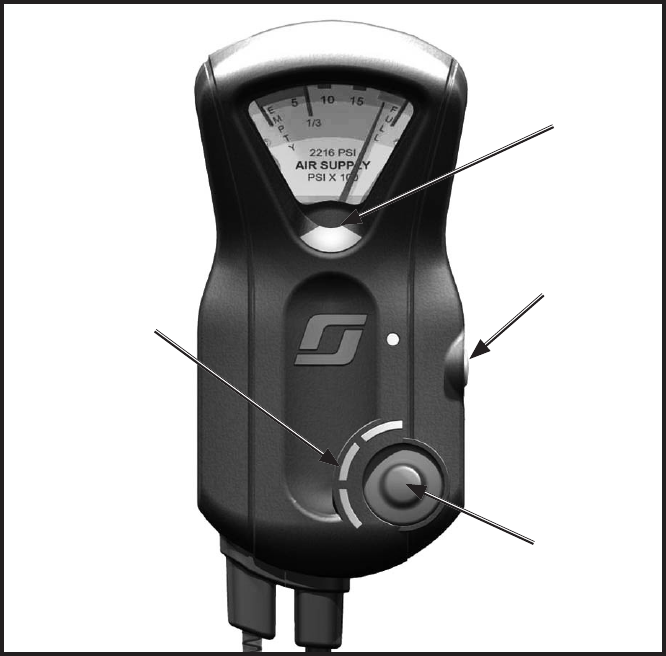
Page 9 of 28 P/N 595277-01 Rev E 10/17
WARNING
THE INFORMATION BELOW IS MEANT TO
SUPPLEMENT, NOT REPLACE, THE TRAINING,
SUPERVISION, MAINTENANCE, AND
OTHER ELEMENTS OF YOUR ORGANIZED
RESPIRATORY PROTECTION PROGRAM.
SEE WARNING ON FIRST PAGE OF THIS
DOCUMENT. FAILURE TO COMPLY WITH THESE
INSTRUCTIONS MAY RESULT IN SERIOUS
INJURY OR DEATH.
WARNING
USERS OF RESPIRATORS EQUIPPED WITH
THE PAK-ALERT DISTRESS ALARM MUST BE
AWARE OF THE PROPER OPERATION OF THE
DISTRESS ALARM. FAILURE TO RECOGNIZE A
MALFUNCTION OF THE PAK-ALERT DISTRESS
ALARM AND TAKE PROPER CORRECTIVE
ACTION MAY RESULT IN SERIOUS INJURY OR
DEATH.
OPERATION OF THE SCOTT PAK-ALERT DISTRESS
ALARM
With proper batteries and a charged air cylinder installed, the PAK-ALERT
distress alarm is automatically activated when the respirator is pressurized
by opening the cylinder valve of the respirator.
To indicate activation, the Sensor Module will sound 3 quick audible chirps
and the green light located on the control console will ash every three (3)
seconds. See FIGURE 4. The PAK-ALERT distress alarm is now in the au-
tomatic mode.
In the automatic mode, the SCOTT PAK-ALERT distress alarm constantly
monitors motion of the respirator backframe. The Sensor Module is located
on the respirator backframe beneath the air cylinder and contains the motion
sensor and the audible alarm. If the Sensor Module does not sense motion
of the respirator for twenty (20) seconds, the PAK-ALERT distress alarm will
signal a pre-alarm condition. If there is still no motion of the respirator for the
next twelve (12) seconds the full alarm will sound.
The SCOTT PAK-ALERT distress alarm will remain activated in the au-
tomatic mode until turned OFF according to these instructions.
RESET BUTTON
(YELLOW BUTTON)
MANUAL ALARM
(RED BUTTON)
PASS
SIGNAL
LIGHTS
FIGURE 4
THE CONTROL CONSOLE
(PRESSURE GAUGE DEPENDS ON SYSTEM PRESSURE–
GAUGE IN ILLUSTRATION IS 2216 PSIG)
EXTERNAL
HEADS UP
DISPLAY
(HUD)
WARNING
IF THE PASS DOES NOT OPERATE AS
DESCRIBED IN THIS SECTION, DO NOT USE
THE SCBA, SET IT ASIDE FOR REPAIR. USE
OF AN PASS DEVICE THAT IS NOT WORKING
CORRECTLY MAY RESULT IN FAILURE TO
ALARM WHEN NEEDED WHICH MAY RESULT IN
SERIOUS PERSONAL INJURY OR DEATH
DRAFT
NOT FOR DISTRIBUTION

Page 10 of 28
P/N 595277-01 Rev E 10/17
PRE-ALARM
If the respirator remains motionless for more than twenty (20) seconds, the
PAK-ALERT distress alarm will automatically sound a pre-alarm
When the pre-alarm occurs, the green ashing light on the control console is
replaced by a bright red light which ashes in cadence with pre-alarm tone and
is accompanied by an ascending/descending audible tone which increases
in volume during the pre-alarm cycle. In addition, the lights in the Heads-Up
Display will ash alternately from one side to the other.
If the respirator user is not incapacitated or not in need of assistance, move
the respirator to reset the pre-alarm. When reset, the ashing red light will
be replaced by the ashing green, the ascending/descending tone will stop,
and the Heads-up Display will return to showing the current cylinder pressure.
Remember that the motion sensor is in the Sensor Module on the respirator
backframe beneath the air cylinder. Actual movement of the respirator back-
frame is required to reset the pre-alarm. Shaking the control console will not
reset the PAK-ALERT distress alarm .
To manually reset the pre-alarm, press and hold the reset button on the
side of the control console until three (3) quick audible chirps are heard
and the red ashing light on the control console is replaced by the green
ashing light.
FULL ALARM
If the respirator remains motionless through the twelve (12) second pre-alarm
cycle, the PAK-ALERT distress alarm will go into full alarm. This may indicate
that the user is incapacitated or in need of assistance and can not move.
Full alarm is indicated by a loud, almost continuous 3 tone chirp from the
Sensor Module accompanied by the ashing red signal light on the control
console. Ten (10) seconds after the full alarm condition starts, the Locator
Transmitter will begin to transmit the unique ID number for the unit. After an
additional (10) second delay, the Pak-Tracker Locator transmitter in the unit
will begin transmitting the unique ID number that can be received by the
Pak-Tracker Hand Held Unit. To reset the full alarm condition, press the reset
button twice. See FIGURE 4.
After the full alarm has been silenced by pressing the reset button twice, the
PAK-ALERT distress alarm will remain activated in the automatic mode with
the green light ashing once per second. As long as the respirator is pres-
surized, there must be movement of the respirator at least every twenty (20)
seconds or the distress alarm will again go into pre-alarm followed by full
alarm as described above.
MANUAL ALARM
If the respirator user requires immediate assistance, pressing the manual alarm
button located on the front of the control console will immediately sound the
full alarm. See FIGURE 4. The manual alarm may be activated at any time,
even when the respirator is not pressurized.
If the manual alarm is activated when the respirator is not pressurized, press
the reset button twice to silence the alarm. The PAK-ALERT distress alarm will
remain on in automatic mode. To turn the unit off, press the reset twice again
while the unit is not in alarm mode. In manual alarm mode, the Pak-Tracker
Locator transmitter in the unit will begin transmitting the unique ID number
that can be received by the Pak-Tracker Hand Held Unit with NO delay.
Remember, the loud audible alarm and ashing red light can be turned on at
any time by pressing the manual alarm button on the control console.
WARNING
USERS OF RESPIRATORS EQUIPPED WITH
THE PAK-ALERT DISTRESS ALARM MUST BE
AWARE OF THE PROPER OPERATION OF THE
DISTRESS ALARM. FAILURE TO RECOGNIZE A
MALFUNCTION OF THE PAK-ALERT DISTRESS
ALARM AND TAKE PROPER CORRECTIVE
ACTION MAY RESULT IN SERIOUS INJURY OR
DEATH.
DRAFT
NOT FOR DISTRIBUTION

Page 11 of 28 P/N 595277-01 Rev E 10/17
WARNING
FAILURE TO REPLACE THE BATTERIES AND/
OR CONTINUING WITH MULTIPLE USES OF
THE RESPIRATOR AFTER THE LOW BATTERY
CONDITION HAS BEEN INDICATED BY THE
PAK-ALERT DISTRESS ALARM MAY RESULT IN
FAILURE OF THE PAK-ALERT DISTRESS ALARM
DURING USE AND POSSIBLE INJURY OR DEATH
OF THE USER.
LOW BATTERY
In a low battery condition, the PAK-ALERT distress alarm will produce a single
audible chirp from the Sensor Module once every two (2) seconds and the
green light on the control module will not ash.
In low battery condition, the PAK-ALERT distress alarm will not emit the 3
beeps when cylinder valve is activated.
While in low battery condition, the PAK-ALERT distress alarm will continue
to operate for a period of time greater then the longest duration cylinder
available for the respirator. However, the batteries must be replaced before
the respirator is used again. See THE BATTERY REPLACEMENT section
of these instructions.
If batteries are completely discharged or have not been installed, there will
be no light or sound and the unit will not operate.
BATTERY TEST
To test the batteries, verify that the PAK-ALERT distress alarm is in the off
condition (cylinder valve closed with no ashing green LED on the control
console). Press and hold the reset button on the console.
A green light on the console will illuminate to indicate sufcient battery power
remaining. If a red light appears, the batteries must be replaced before the
respirator is used again.
TO TURN OFF THE PAK-ALERT DISTRESS ALARM
When use of the respirator with the PAK-ALERT distress alarm is no longer
required, close the cylinder valve on the respirator and vent the residual air
from the respirator system by opening the regulator purge valve. After all the air
ow stops, close the regulator purge valve and press the reset button twice
to turn off the PAK-ALERT distress alarm. If there is air pressure left in the
system, the green ashing light will continue to ash while a fteen second
beep sequence is heard from the Sensor Module as the residual air bleeds
from the system. As soon as the air has completely bled from system, the unit
will sound a quick two tone chirp and the PASS DEVICE distress alarm will
be inactive. If there is no pressure in the system when the RESET button is
pressed twice, there will be no fteen second beep sequence. When the unit
sounds a quick two tone chirp, the PAK-ALERT distress alarm is inactive. If
there is any air pressure left in the system, the PASS DEVICE distress alarm
will return to the active mode.
If the respirator cylinder valve is open and/or pressure remains in the respira-
tor, the PAK-ALERT distress alarm can not be turned off. Pressing the reset
button when the respirator is pressurized will only reset an alarm condition
and return the PAK-ALERT distress alarm to automatic mode.
If the respirator cylinder is turned off and depressurized without pressing the
reset button twice, the PAK-ALERT distress alarm will continue to monitor
motion in automatic mode. This means that the PAK-ALERT distress alarm
may be used to monitor motion after the respirator is turned off and depres-
surized. Resetting the full alarm after the respirator has been depressurized
will not turn off the PAK-ALERT distress alarm. Press the reset switch twice
with no alarm condition to turn off the PAK-ALERT distress alarm (there will
be no fteen (15) second beep sequence and two tone chirp will be heard).
DRAFT
NOT FOR DISTRIBUTION

Page 12 of 28
P/N 595277-01 Rev E 10/17
USE AS PART OF AN ACCOUNTABILITY SYSTEM
TRAINING REQUIRED BEFORE USE. Refer to the PAK-TRACKER Locator
System User Instructions provided with your PAK-TRACKER equipment for
complete details on the use of the PAK-TRACKER Locator System. Use of
this equipment must be part of a complete personnel accountability system
that includes procedures for monitoring the deployment and condition of all
users. Do not rely on the PAK-TRACKER Locator System as the only tech-
nique for locating missing personnel. A Rapid Intervention or Rescue team
using the Hand Held Receiver must have a minimum of two (2) people. For
their own safety, the team members must pay attention to their surroundings
at all times while using the PAK-TRACKER Locator System.
The accountability system must include procedures for alerting the incident
commander and rescue teams when actuated transmitters or the missing
personnel have been found or when they have moved from their previous
location. It is the responsibility of the personnel accountability system to allow
for such contingencies without exposing individuals and teams to unneces-
sary dangers.
WARNING
CONTINUED TRAINING AND PRACTICE IN A
VARIETY OF SITUATIONS IS ESSENTIAL TO
DEVELOPING THE SKILLS TO PROPERLY
INTERPRET THE INFORMATION PROVIDED BY
THE PAK-TRACKER LOCATOR SYSTEM. USE
OF THIS EQUIPMENT WITHOUT TRAINING AND
PRACTICE MAY JEOPARDIZE ALL PERSONNEL
INVOLVED WHICH COULD LEAD TO SERIOUS
INJURY OR DEATH.
PRINCIPLES OF OPERATION OF THE PAK-TRACKER
LOCATOR SYSTEM
The SCOTT PAK-TRACKER locator system is a two part electronic system
consisting of a Hand Held Receiver and a Transmitter. When a Transmitter
is activated, it sends out a radio signal in all directions that is received by the
Hand Held Receiver. Understanding how the radio signal from a Transmitter
behaves and how the Hand Held Receiver receives and displays the strength
of that signal are critical to understanding the operation of the SCOTT PAK-
TRACKER locator system. Successful operation of the PAK-TRACKER
Locator system depends heavily on the interpretation of the relative signal
strength information displayed on the Hand Held Receiver along with all other
available information about the possible location of the activated transmit-
ter.
The Hand Held Receiver is very sensitive in responding to small differences
in signal strength. The relative strength of the Transmitter signal detected by
the Hand Held Receiver will vary depending on:
1. The distance from the Transmitter to the Hand Held Receiver,
2. The path the Transmitter signal has taken to get to the Hand Held Re-
ceiver,
3. The materials between the Transmitter and the Hand Held Receiver which
may have affected the signal from the Transmitter.
The user of the Hand Held Receiver must interpret the readings on the Hand
Held Receiver display along with other information, such as:
– training and knowledge in systematic search and rescue techniques,
– their sense of sight (watch where you are going),
– their sense of sound (listen for an activated PASS device),
– the deployment of the missing personnel,
– knowledge of the building layout and building materials,
Do not rely solely on the readings from the Hand Held Receiver to locate the
activated Transmitter.
Refer to the PAK-TRACKER Locator System User Instructions provided with
your PAK-TRACKER equipment for complete details on the use of the PAK-
TRACKER Locator System.
USE OF THE OPTIONAL SCOTT PAK-TRACKER LO-
CATOR SYSTEM WARNING
READ AND UNDERSTAND THIS ENTIRE MANUAL
AND THE PAK-TRACKER LOCATOR SYSTEM
MANUAL. TRAINING IS REQUIRED BEFORE
USE OF THIS EQUIPMENT IN A HAZARDOUS
SITUATION. THE TRAINING MUST INCLUDE
AN UNDERSTANDING OF THE LIMITATIONS
OF THE EQUIPMENT AND HOW TO INTERPRET
LOCATING INFORMATION, ALONG WITH
EXTENSIVE PRACTICE WITH THE SYSTEM
IN A VARIETY OF ENVIRONMENTS. USE
OF THIS EQUIPMENT MUST A PART OF A
COMPLETE PERSONNEL ACCOUNTABILITY
SYSTEM. ALWAYS UPDATE TRAINING WITH
EACH NEW PIECE OF EQUIPMENT. USE OF A
PAK-TRACKER LOCATOR SYSTEM WITHOUT
PROPER TRAINING MAY PLACE THE USERS
AT HIGHER RISK IN DANGEROUS SITUATIONS
WHICH COULD RESULT IN SERIOUS INJURY
OR DEATH.
DRAFT
NOT FOR DISTRIBUTION
Page 13 of 28 P/N 595277-01 Rev E 10/17
WARNING
KEEP THE ANTENNAS OF HAND-HELD RADIOS
AT LEAST SIX (6) INCHES AWAY FROM THE
CONTROL CONSOLE AND THE SENSOR MODULE
OF THE PAK-ALERT DISTRESS ALARM WHEN
TRANSMITTING. CLOSE PROXIMITY OF RADIO
EQUIPMENT TO THE PAK-ALERT DISTRESS
ALARM DURING RADIO TRANSMISSION MAY
CAUSE THE UNIT TO MALFUNCTION. FAILURE
TO RECOGNIZE A MALFUNCTION OF THE
PAK-ALERT DISTRESS ALARM AND TAKE THE
PROPER CORRECTIVE ACTION MAY RESULT A
NONWORKING DISTRESS ALARM WHICH WILL
NOT SOUND IF THE USER STOPS MOVING AND
LEAD TO SERIOUS INJURY OR DEATH.
WARNING
BE AWARE OF THE POTENTIAL EFFECT OF
RADIO TRANSMISSIONS FROM BASE STATION
OR TRUCK MOUNT RADIOS WHEN USING A
RESPIRATOR WITH THE PAK-ALERT DISTRESS
ALARM. CLOSE PROXIMITY OF RADIO
EQUIPMENT TO THE PAK-ALERT DISTRESS
ALARM DURING RADIO TRANSMISSION MAY
CAUSE THE UNIT TO MALFUNCTION. FAILURE
TO RECOGNIZE A MALFUNCTION OF THE
PAK-ALERT DISTRESS ALARM AND TAKE THE
PROPER CORRECTIVE ACTION MAY RESULT A
NONWORKING DISTRESS ALARM WHICH WILL
NOT SOUND IF THE USER STOPS MOVING AND
LEAD TO SERIOUS INJURY OR DEATH.
DETECTING AND AVOIDING RADIO FREQUENCY
INTERFERENCE
When any electronic device is adversely affected by radio waves, Radio
Frequency Interference (RFI) is said to have occurred. All electronic devices
like the PAK-ALERT distress alarm may be subject to the effects of RFI. Ra-
dio transmissions from the antennas of radios including those used by re
ghters, police and other public safety related personnel may produce RFI
in the PAK-ALERT distress alarm. RFI may occur while the radio is transmit-
ting if the respirator equipped with the PAK-ALERT distress alarm is in close
proximity to a base station or high-powered vehicle mounted radio, or if the
antenna of a personal portable hand held radio is touching or within six (6)
inches of the Control Console or Sensor Module of the PAK-ALERT distress
alarm. See FIGURE 5.
Be aware of the symptoms of RFI. A PAK-ALERT distress alarm affected by
RFI may temporarily give false indications such as the sudden sounding of
the loud continuous three-tone chirp of the full alarm. In some instances the
lights on the control console may ash without sounding the alarm. In rare
circumstances, an alarm which was sounding may stop.
If the PAK-ALERT exhibits any of the symptoms of RFI, identify the source
of the RFI and do the following:
– If the symptoms of RFI occur when standing near a base station trans-
mitting antenna or a truck mounted radio antenna, move away from the
antenna until the symptoms stop.
– If the symptoms of RFI occur while transmitting on a hand-held radio,
move the radio away from the PAK-ALERT .
CHECK THE CONTROL CONSOLE AND BE CERTAIN THE GREEN LIGHT
IS FLASHING NORMALLY WHEN THE INTERFERENCE STOPS, REGARD-
LESS OF THE SOURCE.
In normal usage with the air cylinder open, the PAK-ALERT distress alarm
DRAFT
NOT FOR DISTRIBUTION
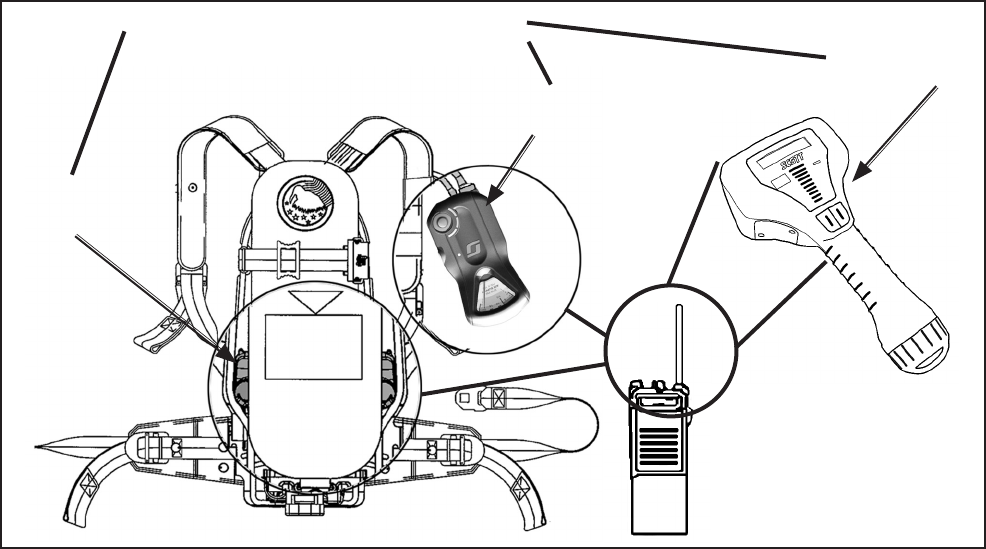
Page 14 of 28
P/N 595277-01 Rev E 10/17
will typically resume normal operation after experiencing RFI.
If the PAK-ALERT distress alarm is affected by RFI when the respirator air
supply is turned off or the cylinder is empty, the distress alarm could be
turned off during use. If this occurs, depress the RED Manual Alarm Button
to activate the alarm.
IF THE SYMPTOMS OF RFI OCCUR, THE RESPIRATOR USER MUST
CHECK THE PAK-ALERT DISTRESS ALARM TO VERIFY THAT IT IS FUNC-
TIONING PROPERLY. IF THE GREEN LIGHT ON THE CONTROL CONSOLE
DOES NOT RESUME FLASHING IN THE NORMAL MANNER AFTER EX-
PERIENCING THE SYMPTOMS OF RFI, OR IF THE UNIT CONTINUES
TO MALFUNCTION IN ANY OTHER WAY, PROCEED TO A SAFE AREA,
REMOVE THE RESPIRATOR FROM SERVICE AND TAG FOR REPAIR BY
AUTHORIZED PERSONNEL.
Minimize or eliminate the effects of RFI by protecting the PAK-ALERT with
the following steps:
– Maintain a safe distance from a base station transmitting antenna or a
truck mounted radio antenna.
– Keep the antennas of hand held radios at least six (6) inches away from the
CONTROL CONSOLE or the SENSOR MODULE. See FIGURE 5.
FIGURE 5
RFI WARNING AREAS
RFI AND THE PAK-TRACKER HAND HELD RECEIVER
If the Hand Held Receiver experiences RFI, it may be necessary to remove
the Hand Held Receiver from service. In a known safe, non-hazardous
area, remove and reinstall the batteries to reset the unit (see the BATTERY
REPLACEMENT section of the PAK-TRACKER Locator System User
Instructions provided with your PAK-TRACKER equipment). Then inspect
and return the Hand Held Receiver to service.
HAND HELD
RECEIVER
SENSOR
MODULE
CONTROL
CONSOLE
KEEP RADIO ANTENNAS AT LEAST
SIX (6) INCHES FROM THESE AREAS
DRAFT
NOT FOR DISTRIBUTION
Page 15 of 28 P/N 595277-01 Rev E 10/17
WARNING
FOLLOW REGULAR OPERATIONAL INSPECTION
PROCEDURE EXACTLY. IF THE PAK-ALERT
DISTRESS ALARM DOES NOT ACTUATE, OR
DOES NOT OPERATE AS DESCRIBED OR IF
ANY OTHER OPERATIONAL MALFUNCTION IS
NOTED, DO NOT USE THE RESPIRATOR.
WARNING
IN SEVERAL OF THE INSPECTION PROCEDURES
DESCRIBED A FULL ALARM WILL BE OBSERVED.
THE FULL ALARM CONDITION INCLUDES AN
AUDIBLE TONE THAT CAN EXCEED 95 DBA AT
3 METERS (9.9 FT.). TO PREVENT POSSIBLE
HEARING DAMAGE DURING TEST, IMMEDIATELY
RESET THE ALARM ON VERIFICATION THAT IT
IS FUNCTIONING PROPERLY. WEAR HEARING
PROTECTION IF PROLONGED OR REPEATED
EXPOSURE TO A FULL ALARM CONDITION IS
ANTICIPATED.
CAUTION
THE PERFORMANCE PROPERTIES OF THE
PAK-ALERT DISTRESS ALARM CANNOT BE
PROPERLY TESTED IN THE FIELD.
Inspect and test the SCOTT PAK-ALERT distress alarm along with the inspec-
tion and test of the SCOTT SCBA respirator before each use. Include the
following inspection procedures with the REGULAR OPERATIONAL INSPEC-
TION procedures dened in your respirator instructions. If any malfunction of
the respirator or the PAK-ALERT distress alarm is noted during the inspection,
remove the respirator from service and tag for repair by authorized personnel.
WARNING
THE PROPER OPERATION OF THE LOCATOR
SYSTEM CANNOT BE CHECKED WITHOUT
CHECKING ALL COMPONENTS OF THE SYSTEM
TOGETHER. THE REGULAR OPERATIONAL
INSPECTION MUST INCLUDE THE HAND HELD
RECEIVER AND THE TRANSMITTERS IN THE
PAK-TRACKER LOCATOR SYSTEM SPECIALLY
EQUIPPED PAK-ALERT DISTRESS ALARM
WORKING WITH EACH OTHER TO CONFIRM
PROPER OPERATION. FAILURE TO PROPERLY
INSPECT THE COMPLETE SYSTEM MAY RESULT
IN FAILURE OF ONE COMPONENT WHICH
COULD LEAD TO SERIOUS INJURY OR DEATH.
REGULAR OPERATIONAL INSPECTION
INSPECTION OF A PAK-ALERT DISTRESS ALARM
NOTE
IN SEVERAL OF THE INSPECTION PROCEDURES DESCRIBED A
FULL ALARM WILL BE OBSERVED. THE FULL ALARM CONDITION
INCLUDES AN AUDIBLE TONE THAT CAN EXCEED 95 DBA AT 3 ME-
TERS (9.9 FT.). TO PREVENT POSSIBLE HEARING DAMAGE DURING
TEST, IMMEDIATELY RESET THE ALARM ON VERIFICATION THAT IT
IS FUNCTIONING PROPERLY. WEAR HEARING PROTECTION IF PRO-
LONGED OR REPEATED EXPOSURE TO A FULL ALARM CONDITION
IS ANTICIPATED.
NOTE
IF THIS INSPECTION IS DONE IN DIRECT SUNLIGHT IT MAY BE HELPFUL
TO SHADE THE LENS ON THE CONTROL CONSOLE WITH YOUR HAND
TO BE SURE THE LIGHTS ARE FLASHING AS DESCRIBED.
1. While performing the visual inspection of the respirator, visually inspect
all distress alarm enclosures, lenses, and wire conduits for cracks, wear
or other damage. If any damage is found, remove the respirator from
service and tag for repair by qualied personnel.
2. With the cylinder valve closed, press the manual alarm button, located
on the front of the distress alarm control console. The manual alarm shall
sound a loud almost continuous 3 tone chirp accompanied by ashing of
the red signal light on the control console.
3. Reset the manual alarm by pressing twice on the reset button located
on the side of the control console (fully depress reset button, release
and press again). The unit will sound three chirps and the green light
will ash.
4. Turn the PAK-ALERT distress alarm OFF by pressing the reset button
twice again. The unit will sound a two tone chirp and the green light will
go out.
5. Open the cylinder valve to pressurize the respirator system. The distress
alarm shall sound 3 quick chirps and the light on the control console
shall begin ashing green about once a second. The 3 chirps will sound
approximately the same time the VIBRALERT in the mask mounted
regulator actuates briey. Make sure the air ow is stopped by pressing
the air saver/donning switch.
6. To check the pre-alarm, leave respirator motionless for twenty (20) sec-
onds. The green ashing light shall be replaced by a red ashing light.
An ascending/descending tone will sound increasing in volume. Leave
the respirator motionless.
If your PAK-ALERT is NOT equipped with the optional PAK-TRACKER Locator
System, perform the REGULAR OPERATIONAL INSPECTION as dened
on Page 12-13 of this instruction.
If your PAK-ALERT IS equipped with the optional PAK-TRACKER Locator
System (as signied by the two RED PAK-TRACKER labels on the Sensor
Module), perform the REGULAR OPERATIONAL INSPECTION as dened
on Page 14-16 of this instruction.
DRAFT
NOT FOR DISTRIBUTION
Page 16 of 28
P/N 595277-01 Rev E 10/17
7. After the pre-alarm condition occurs, check the pre-alarm reset. Within
twelve (12) seconds of the pre-alarm, move the respirator to activate the
motion sensor. The PAK-ALERT distress alarm shall reset to the automatic
mode. The red ashing light shall be replaced by a green ashing light
and the ascending/descending tone shall stop.
Continue with regular operational inspection of respirator as directed by
respirator instructions or your approved respiratory protection plan proce-
dure. During the inspection the respirator must be moved or turned every
thirty (30) seconds or less to prevent the sounding of the full alarm.
After completion of all respirator checks and before turning off the
cylinder valve:
1. Check the manual reset of the pre-alarm. Leave the respirator motionless
until pre-alarm condition occurs. Within twelve (12) seconds press and
hold the reset button. Three (3) chirps shall sound, then release button.
The distress alarm shall reset to the automatic mode and the ashing red
light will be replaced by a ashing green light.
2. To check the full alarm, leave the respirator motionless until the pre-alarm
condition occurs. Do not reset. The full alarm shall sound a loud almost
continuous 3 tone chirp accompanied by ashing of the red signal light
on the control console.
3. Reset the full alarm by pressing twice on the reset button located on
the side of the control console (fully depress reset button, release
and press again). The loud alarm shall stop. The unit will sound three
chirps and the green light will ash. The unit shall reset to the automatic
mode.
4. Finish all respirator checks involving air ow and turn off the cylinder valve.
Use the purge valve to release all residual air pressure in the system.
With the cylinder valve OFF:
1. Check the continuing operation of the distress alarm. The distress alarm
shall remain active with green light ashing. Do not move respirator,
pre-alarm shall occur with twenty (20) seconds. Move respirator slightly,
pre-alarm shall reset, green light shall start ashing again.
2. To turn the distress alarm off, press the reset button twice (press, release
and press again). If there is air pressure left in the system, the green
ashing light will continue to ash while a fteen second beep sequence
is heard from the Sensor Module as the residual air bleeds from the
system. As soon as the air has completely bled from system, the unit will
sound a quick two tone chirp and the PAK-ALERT distress alarm will be
inactive. If there is no air pressure in the system when the RESET button
is pressed twice, there will be no beep sequence, only the quick two tone
chirp. The distress alarm is now in the "OFF" condition. If there is any air
pressure left in the system, the PAK-ALERT distress alarm will return to
the active mode.
NOTE
IF THE LOW BATTERY INDICATION (ONE STEADY CHIRP EVERY TWO (2)
SECONDS WITH NO FLASHING LIGHTS) OCCURS AT ANY TIME DURING
REGULAR OPERATIONAL INSPECTION, DO NOT USE THE RESPIRATOR.
CHANGE THE BATTERIES IN THE SENSOR MODULE IMMEDIATELY AND
REPEAT THE REGULAR OPERATIONAL TEST OR TAKE THE RESPIRA-
TOR OUT OF SERVICE UNTIL THE BATTERIES ARE CHANGED AND THE
REGULAR OPERATIONAL TEST IS SUCCESSFULLY PERFORMED.
WARNING
IF THE LOW BATTERY INDICATION (ONE
STEADY CHIRP EVERY TWO (2) SECONDS
WITH NO FLASHING LIGHTS) OCCURS AT
ANY TIME DURING REGULAR OPERATIONAL
INSPECTION, DO NOT USE THE RESPIRATOR.
CHANGE THE BATTERIES IN THE SENSOR
MODULE IMMEDIATELY AND REPEAT THE
REGULAR OPERATIONAL TEST OR TAKE THE
RESPIRATOR OUT OF SERVICE UNTIL THE
BATTERIES ARE CHANGED AND THE REGULAR
OPERATIONAL TEST IS SUCCESSFULLY
PERFORMED. FAILURE TO REPLACE THE
BATTERIES AND/OR CONTINUING WITH
MULTIPLE USES OF THE RESPIRATOR AFTER
THE LOW BATTERY CONDITION HAS BEEN
INDICATED BY THE PAK-ALERT DISTRESS
ALARM MAY RESULT IN FAILURE OF THE PAK-
ALERT DISTRESS ALARM DURING USE AND
POSSIBLE INJURY OR DEATH OF THE USER.
DRAFT
NOT FOR DISTRIBUTION
Page 17 of 28 P/N 595277-01 Rev E 10/17
INSPECTION OF A PAK-ALERT DISTRESS ALARM WITH
OPTIONAL PAK-TRACKER LOCATOR SYSTEM
Inspect and test the SCOTT PAK-TRACKER Locator System specially
equipped PAK-ALERT distress alarm along with the inspection and test of the
SCOTT SCBA respirator before each use. Refer to the PAK-TRACKER User
Instructions provided with the SCOTT PAK-TRACKER Hand Held Receiver for
complete details. Include the following inspection procedures with the REGU-
LAR OPERATIONAL INSPECTION procedures dened in your respirator
instructions. If any malfunction of the respirator, the PAK-TRACKER Locator
System, or the PAK-ALERT distress alarm is noted during the inspection,
remove the respirator from service and tag for repair by authorized personnel.
To test the PAK-TRACKER locator transmitter, you must have an operating
SCOTT PAK-TRACKER Hand Held Receiver.
WARNING
FOLLOW REGULAR OPERATIONAL INSPECTION
PROCEDURE EXACTLY. IF THE PAK-ALERT
DISTRESS ALARM DOES NOT ACTUATE, OR
DOES NOT OPERATE AS DESCRIBED OR IF
ANY OTHER OPERATIONAL MALFUNCTION IS
NOTED, DO NOT USE THE RESPIRATOR.
CAUTION
THE PERFORMANCE PROPERTIES OF THE
PAK-ALERT DISTRESS ALARM CANNOT BE
PROPERLY TESTED IN THE FIELD.
WARNING
THE PROPER OPERATION OF THE LOCATOR
SYSTEM CANNOT BE CHECKED WITHOUT
CHECKING ALL COMPONENTS OF THE SYSTEM
TOGETHER. THE REGULAR OPERATIONAL
INSPECTION MUST INCLUDE THE HAND HELD
RECEIVER AND THE TRANSMITTERS IN THE
PAK-TRACKER LOCATOR SYSTEM SPECIALLY
EQUIPPED PAK-ALERT DISTRESS ALARM
WORKING WITH EACH OTHER TO CONFIRM
PROPER OPERATION. FAILURE TO PROPERLY
INSPECT THE COMPLETE SYSTEM MAY RESULT
IN FAILURE OF ONE COMPONENT WHICH
COULD LEAD TO SERIOUS INJURY OR DEATH.
WARNING
IN SEVERAL OF THE INSPECTION PROCEDURES
DESCRIBED A FULL ALARM WILL BE OBSERVED.
THE FULL ALARM CONDITION INCLUDES AN
AUDIBLE TONE THAT CAN EXCEED 95 DBA AT
3 METERS (9.9 FT.). TO PREVENT POSSIBLE
HEARING DAMAGE DURING TEST, IMMEDIATELY
RESET THE ALARM ON VERIFICATION THAT IT
IS FUNCTIONING PROPERLY. WEAR HEARING
PROTECTION IF PROLONGED OR REPEATED
EXPOSURE TO A FULL ALARM CONDITION IS
ANTICIPATED.
NOTE
IN SEVERAL OF THE INSPECTION PROCEDURES DESCRIBED A
FULL ALARM WILL BE OBSERVED. THE FULL ALARM CONDITION
INCLUDES AN AUDIBLE TONE THAT CAN EXCEED 95 DBA AT 3 ME-
TERS (9.9 FT.). TO PREVENT POSSIBLE HEARING DAMAGE DURING
TEST, IMMEDIATELY RESET THE ALARM ON VERIFICATION THAT IT
IS FUNCTIONING PROPERLY. WEAR HEARING PROTECTION IF PRO-
LONGED OR REPEATED EXPOSURE TO A FULL ALARM CONDITION
IS ANTICIPATED.
NOTE
IF THIS INSPECTION IS DONE IN DIRECT SUNLIGHT IT MAY BE HELPFUL
TO SHADE THE LENS ON THE CONTROL CONSOLE WITH YOUR HAND
TO BE SURE THE LIGHTS ARE FLASHING AS DESCRIBED.
1. While performing the visual inspection of the respirator, visually inspect
all distress alarm enclosures, lenses, and wire conduits for cracks, wear
or other damage. If any damage is found, remove the respirator from
service and tag for repair by qualied personnel.
2. Turn on the SCOTT PAK-TRACKER Hand Held Receiver according to
the operating instructions provided with the unit. Position the Hand Held
Receiver near by.
3. With the cylinder valve closed, press the manual alarm button, located
on the front of the distress alarm control console.
a) The manual alarm shall sound a loud almost continuous 3 tone chirp ac-
companied by ashing of the red signal light on the control console.
b) The PAK-TRACKER Hand Held Receiver will sound an alarm and display
the Identication Number of the PAK-TRACKER Locator System spe-
cially equipped PAK-ALERT distress alarm which appears on the label
on the Sensor Module or the Control Console. Use the SCROLL button
on the Hand Held Receiver to highlight the active ID number and press
the ENTER button on the Hand Held Receiver to select the displayed ID
number. Point the unit directly at and in close proximity to the respirator.
The signal strength displayed will be at its highest value.
4. Reset the manual alarm by pressing twice on the reset button located
on the side of the control console (fully depress reset button, release
and press again).
a) The unit will sound three chirps and the green light will ash.
b) The PAK-TRACKER Hand Held Receiver will reset to its non-alarm
state.
5. Turn the PAK-TRACKER Locator System specially equipped PAK-ALERT
distress alarm OFF by pressing the reset button twice again. The unit
will sound a two tone chirp and the green light will go out.
DRAFT
NOT FOR DISTRIBUTION
Page 18 of 28
P/N 595277-01 Rev E 10/17
6. Open the cylinder valve to pressurize the respirator system. The distress
alarm shall sound 3 quick chirps and the light on the control console
shall begin ashing green about once a second. The 3 chirps will sound
approximately the same time the VIBRALERT in the mask mounted
regulator actuates briey. Make sure the air ow is stopped by pressing
the air saver/donning switch.
7. To check the pre-alarm, leave respirator motionless for twenty (20) sec-
onds. The green ashing light shall be replaced by a red ashing light.
An ascending/descending tone will sound increasing in volume. Leave
the respirator motionless.
8. After the pre-alarm condition occurs, check the pre-alarm reset. Within
twelve (12) seconds of the pre-alarm, move the respirator to activate the
motion sensor. The PAK-TRACKER Locator System specially equipped
PAK-ALERT distress alarm shall reset to the automatic mode. The red
ashing light shall be replaced by a green ashing light and the ascend-
ing/descending tone shall stop.
Continue with regular operational inspection of respirator as directed by
respirator instructions or your approved respiratory protection plan proce-
dure. During the inspection the respirator must be moved or turned every
thirty (30) seconds or less to prevent the sounding of the full alarm.
After completion of all respirator checks and before turning off the
cylinder valve:
1. Check the manual reset of the pre-alarm. Leave the respirator motionless
until pre-alarm condition occurs. Within twelve (12) seconds press and
hold the reset button. Three (3) chirps shall sound, then release button.
The distress alarm shall reset to the automatic mode and the ashing red
light will be replaced by a ashing green light.
2. To check the full alarm, leave the respirator motionless until the pre-alarm
condition occurs. Do not reset.
a) The full alarm shall sound a loud almost continuous 3 tone chirp accom-
panied by ashing of the red signal light on the control console.
b) The PAK-TRACKER Hand Held Receiver will sound an alarm and display
the Identication Number of the PAK-TRACKER Locator System spe-
cially equipped PAK-ALERT distress alarm which appears on the label
on the Sensor Module or the Control Console. Use the SCROLL button
on the Hand Held Receiver to highlight the active ID number and press
the ENTER button on the Hand Held Receiver to select the displayed ID
number. Point the unit directly at and in close proximity to the respirator.
The signal strength displayed will be at its highest value.
3. Reset the full alarm by pressing twice on the reset button located on the
side of the control console (fully depress reset button, release and
press again).
a) The loud alarm shall stop. The unit will sound three chirps and the green
light will ash. The unit shall reset to the automatic mode.
b) The PAK-TRACKER Hand Held Receiver will reset to its non-alarm
state.
4. Finish all respirator checks involving air ow and turn off the cylinder valve.
Use the purge valve to release all residual air pressure in the system.
WARNING
IF THE LOW BATTERY INDICATION (ONE
STEADY CHIRP EVERY TWO (2) SECONDS
WITH NO FLASHING LIGHTS) OCCURS AT
ANY TIME DURING REGULAR OPERATIONAL
INSPECTION, DO NOT USE THE RESPIRATOR.
CHANGE THE BATTERIES IN THE SENSOR
MODULE IMMEDIATELY AND REPEAT THE
REGULAR OPERATIONAL TEST OR TAKE THE
RESPIRATOR OUT OF SERVICE UNTIL THE
BATTERIES ARE CHANGED AND THE REGULAR
OPERATIONAL TEST IS SUCCESSFULLY
PERFORMED. FAILURE TO REPLACE THE
BATTERIES AND/OR CONTINUING WITH
MULTIPLE USES OF THE RESPIRATOR AFTER
THE LOW BATTERY CONDITION HAS BEEN
INDICATED BY THE PAK-ALERT DISTRESS
ALARM MAY RESULT IN FAILURE OF THE PAK-
ALERT DISTRESS ALARM DURING USE AND
POSSIBLE INJURY OR DEATH OF THE USER.
DRAFT
NOT FOR DISTRIBUTION
Page 19 of 28 P/N 595277-01 Rev E 10/17
With the cylinder valve OFF:
1. Check the continuing operation of the distress alarm. The distress alarm
shall remain active with green light ashing. Do not move respirator,
pre-alarm shall occur with twenty (20) seconds. Move respirator slightly,
pre-alarm shall reset, green light shall start ashing again.
2. To turn the distress alarm off, press the reset button twice (press, release
and press again). If there is air pressure left in the system, the green
ashing light will continue to ash while a fteen second beep sequence
is heard from the Sensor Module as the residual air bleeds from the
system. As soon as the air has completely bled from system, the unit will
sound a quick two tone chirp and the PASS DEVICE distress alarm will
be inactive. If there is no pressure in the system when the RESET but-
ton is pressed twice, there will be no beep sequence. The distress alarm
is now in the “OFF” condition. If there is air pressure in the system, the
PASS DEVICE distress alarm will return to the active mode.
NOTE
IF THE LOW BATTERY INDICATION (ONE STEADY CHIRP EVERY TWO (2)
SECONDS WITH NO FLASHING LIGHTS) OCCURS AT ANY TIME DURING
REGULAR OPERATIONAL INSPECTION, DO NOT USE THE RESPIRATOR.
CHANGE THE BATTERIES IN THE SENSOR MODULE IMMEDIATELY AND
REPEAT THE REGULAR OPERATIONAL TEST OR TAKE THE RESPIRA-
TOR OUT OF SERVICE UNTIL THE BATTERIES ARE CHANGED AND THE
REGULAR OPERATIONAL TEST IS SUCCESSFULLY PERFORMED.
DRAFT
NOT FOR DISTRIBUTION

Page 20 of 28
P/N 595277-01 Rev E 10/17
When performing the REGULAR OPERATIONAL INSPECTION verify that
the Sensor Module lights are operating as described below:
OPERATION OF SENSOR MODULE LIGHTS
NOTE
THE ORANGE LIGHT IS A COMBINATION OF THE RED, GREEN, AND
WHITE LIGHTS THAT APPEARS ORANGE FROM A DISTANCE. AT
CLOSE RANGE THE INDIVIDUAL LIGHTS MAY BE VISIBLE.
ACTION... SENSOR MODULE LIGHTS WILL…
Start up PASS (Open Cylinder) .............................Bright Light then Flash GREEN
Normal Operation ...................................................Flash GREEN
Respirator Air between 1/2 and 1/3 cylinder .......... Flash ORANGE (two quick ashes) every one (1) second
(available on units manufactured after 09/2015)
Respirator Low air (1/3 cylinder) ............................ Flash ORANGE (alternately)
Low Battery while ON ............................................Flash ORANGE once every two (2) seconds
Shut down .............................................................Lights OFF
Press RESET w/unit OFF (BATTERY TEST) .......Bright Light then:
Flash GREEN if Good/Flash RED if Low
Press MANUAL ALARM with unit OFF .................Flash GREEN then Full Alarm Flash RED
Press RESET from manual alarm .........................Returns to Flash GREEN
PASS Pre-Alarm ...................................................Flash RED (alternately)
PASS Full alarm ..................................................... Flash RED (simultaneously)
DRAFT
NOT FOR DISTRIBUTION

Page 21 of 28 P/N 595277-01 Rev E 10/17
WARNING
READ AND UNDERSTAND THE COMPLETE INSTRUCTION MANUAL BEFORE USING A
RESPIRATOR WITH A PAK-ALERT DISTRESS ALARM INSTALLED.
WHEN THE PAK-ALERT
DISTRESS ALARM IS: IT INDICATES THAT:
Quiet. No lights or sound
Flashing the green light
Flashing the red light and sounding an
ascending/descending tone.
Flashing the red light and sounding a
loud continuous 3 tone chirp
Chirping once every two (2) seconds with
no light ashing
The PAK-ALERT distress alarm is off or
the batteries are used up or removed.
The PAK-ALERT distress alarm is on, in
automatic mode, and monitoring your mo-
tion.
You have not moved in the last twenty (20)
seconds, PAK-ALERT distress alarm will
go into full alarm in twelve (12) seconds or
less if you do not move.
Full alarm: You have not moved in the last
thirty (30) seconds or more or you pushed
the manual alarm button.
The batteries are low. You must put in new
batteries before using the PAK-ALERT
distress alarm again (it will work in low
battery condition long enough to let you
nish the cylinder of air you are on).
QUICK REFERENCE GUIDE TO USE:
WHEN YOU WANT TO: YOU DO: THE PAK-ALERT DISTRESS
ALARM DOES:
Turn it on.
Re-set pre-alarm
Re-set full alarm
Turn it off (nished with use)
Turn on the manual alarm.
Open cylinder valve (cylinder
must have air in it).
Move so that the respirator
moves.
3 quick audible chirps, green
ashing light on control console.
Red ashing light changes to
green, ascending/descending
tone stops.
Loud 3 tone chirp stops, 3 quick
chirps, then red ashing light
changes to green ashing light.
The ashing light goes out and
a fteen (15) second beep se-
quence occurs as the residual air
bleeds off. Unit will sound a two
tone chirp at turn off.
Goes into full alarm, loud 3 tone
chirps from Sensor Module and
bright red ashing light from con-
trol console.
Press re-set button on control
console twice (push, release,
push again).
Close respirator cylinder valve,
open regulator purge valve
letting out all the trapped air,
close regulator purge valve,
press re-set button twice.
Press alarm button on control
console (works whether the
PAK-ALERT distress alarm is
on or off).
DRAFT
NOT FOR DISTRIBUTION
Page 22 of 28
P/N 595277-01 Rev E 10/17
CLEANING, MAINTENANCE AND STORAGE
Cleaning, maintenance and storage of a respirator with a PAK-TRACKER
Locator System specially equipped PAK-ALERT distress alarm shall be done
as part of the normal respirator CLEANING AND STORAGE and REGULAR
OPERATIONAL INSPECTION as described in the OPERATING AND MAIN-
TENANCE INSTRUCTIONS supplied with each SCOTT respirator.
Refer to the PAK-TRACKER User Instructions provided with the SCOTT PAK-
TRACKER Hand Held Receiver for complete details of cleaning and storage
of the Hand Held Receiver.
Store the respirator and attached distress alarm in accordance with the
OPERATION AND MAINTENANCE INSTRUCTIONS provided with the res-
pirator. Do not store respirators equipped with distress alarms in the proximity
of radio antennas or radio transmitter base units. Respirators equipped with
PAK-ALERT distress alarms must be stored or transported at least two (2)
feet away from radio antennas on re equipment.
Clean the exterior of the PAK-ALERT distress alarm while cleaning the
exterior of the respirator by wiping with a damp sponge and thoroughly
wiping dry. The Signal Light lens on the front of the control console, shown
in FIGURE 4, should be cleaned after every use to insure maximum light
intensity at all times. Do not use solvents for cleaning or attempt to paint
or apply decals to the exterior surfaces of the PAK-ALERT distress alarm.
If during use, the respirator and/or PAK-ALERT distress alarm is sus-
pected of being contaminated by a hazardous substance, the contaminant
must be identied and properly removed or the contaminated component(s)
must be replaced before next use. Dispose of the contaminant or the contami-
nated component(s) in accordance with applicable regulatory requirements.
Except for the replacement of batteries, no attempt shall be made to do
maintenance or to make adjustments or repairs beyond the scope of this
instruction manual without proper training.
MARKING AND PAINTING
Do not mark, etch, paint, or drill any of the Pak-Alert components or hous-
ings in any way.
REPLACEMENT PARTS AND SERVICE
The PAK-ALERT distress alarm is covered by a one year warranty.
Consult your Authorized SCOTT Representative, Distributor or Service Center
as to the availability of Service and Parts for the PAK-ALERT distress alarm.
Replacement Batteries of the type designated are commercially available
over the counter, from your SCOTT Distributor, and from most Industrial
Battery Distributors.
Except for the replacement of batteries, no attempt shall be made to do
maintenance or to make adjustments or repairs beyond the scope of this
instruction manual without proper training.
RETIREMENT CRITERIA AND CONSIDERATION
Retirement criteria and consideration shall be determined by SCOTT trained
and Certied Overhaul Technicians.
DRAFT
NOT FOR DISTRIBUTION
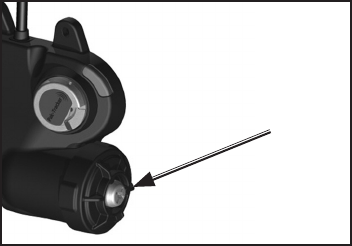
Page 23 of 28 P/N 595277-01 Rev E 10/17
CAUTION
RESPIRATOR SYSTEM MUST NOT BE
PRESSURIZED WHEN BATTERIES ARE BEING
INSTALLED. DAMAGE TO THE ELECTRONIC
COMPONENTS MAY RESULT IF BATTERIES
ARE INSTALLED WITH SYSTEM PRESSURIZED.
SCOTT respirators equipped with the PAK-ALERT distress alarm
require six (6) “AA” cell batteries for operation. The six (6) batteries
power the Heads-Up Display, the PASS device, and the PAK-TRACK-
ER Transmitter. The batteries should be replaced only by a trained
maintenance technician in a clean area known to be nonflammable.
NOTE
WHEN RECEIVING AIR-PAK RESPIRATORS, THE USER SHOULD UP-
DATE THE ELECTRONICS TO THE LOCAL TIME ZONE USING THE
PAK-LINK PROGRAMMER (P/N 200673-01).
Replace batteries as follows:
1. Close respirator cylinder valve, open regulator purge valve letting out
all the trapped air, close regulator purge valve, press the reset button
twice. If there is air pressure left in the system, the green ashing light will
continue to ash while a fteen second beep sequence is heard from the
Sensor Module as the residual air bleeds from the system. As soon as
the air has completely bled from system, the unit will sound a quick two
tone chirp and the PASS DEVICE distress alarm will be inactive. If there
is no pressure in the system when the RESET button is pressed twice,
there will be no beep sequence. If there is air pressure in the system, the
PASS DEVICE distress alarm will return to the active mode.
NOTE
ALWAYS BE SURE THAT CYLINDER VALVE IS OFF AND THE PASS
DEVICE IS COMPLETELY INACTIVE BEFORE CHANGING BATTERIES.
NEVER REMOVE OR REPLACE BATTERIES WITH SYSTEM PRESSUR-
IZED OR DAMAGE MAY OCCUR TO ELECTRONIC COMPONENTS.
2. When replacing batteries on respirators, remove the cylinder and place
the respirator in a clean, non-hazardous area.
3. Use a Phillips driver to remove the Battery Housing Cover as shown in
FIGURE 6. Carefully remove the cover and set aside.
4. Remove used batteries from battery compartment by sliding them out of
the battery compartment.
5. Install six (6) fresh new “AA” batteries of the same type. Always replace
all batteries at the same time.
The battery holder is marked with the style and orientation of the batteries
required. See FIGURE 7.
Use six (6) each of one of the following 1.5 volt AA batteries:
– Duracell2 Alkaline MN1500
– Duracell Alkaline MX1500
– Duracell Alkaline PC1500
– Duracell Quantum QU1500
– Energizer3 Alkaline EN91
– Energizer Alkaline E91
Do not mix batteries. Verify correct orientation of batteries as shown on
label inside the battery holder.
WARNING
THE PAK-ALERT DISTRESS ALARM IS INTENDED
TO ASSIST IN LOCATING A PERSON WHO
MAY BE IN A LIFE THREATENING SITUATION.
FAILURE TO FOLLOW THE INSTRUCTIONS FOR
OPENING, CHANGING THE BATTERIES AND
RE-CLOSING THE BATTERY COMPARTMENT
MAY RESULT IN DAMAGE WHICH COULD
CAUSE FAILURE OF THE PASS DURING A LIFE
THREATENING EMERGENCY OR COULD CAUSE
A FIRE OR EXPLOSION IN A FLAMMABLE
OR EXPLOSIVE ATMOSPHERE POSSIBLY
RESULTING IN INJURY OR DEATH.
WARNING
BATTERIES MUST ONLY BE CHANGED IN AN
AREA KNOWN TO BE NONFLAMMABLE.
CHANGING THE BATTERIES IN A FLAMMABLE
ATMOSPHERE MAY CAUSE AN IGNITION
WHICH COULD RESULT IN SERIOUS INJURY
OR DEATH.
BATTERY REPLACEMENT
2 Duracell is a registered trademark of The Procter & Gamble Company, Cincinnati, OH
3 Energizer is a registered trademark of Eveready Battery Company, Inc., St Louis, MO.
WARNING
TO REDUCE THE RISK OF EXPLOSION USE
BATTERIES ONLY FROM THE LIST PROVIDED,
DO NOT MIX OLD BATTERIES WITH UNUSED
BATTERIES, AND DO NOT MIX BATTERIES FROM
DIFFERENT MANUFACTURERS. UNAUTHORIZED
SUBSTITUTION OF COMPONENTS MAY IMPAIR
INTRINSIC SAFETY AND CAUSE AN EXPLOSION
WHICH COULD LEAD TO SERIOUS INJURY OR
DEATH.
FIGURE 6
USE SCREWDRIVER
TO LOOSEN SCREW
AND REMOVE COVER
WARNING
ALWAYS INSTALL THE BATTERIES IN THE
ORIENTATION SHOWN ON THE LABEL. FAILURE
TO PROPERLY INSTALL THE BATTERIES
WILL RESULT IN EITHER REDUCED OR NO
OPERATION OF THE EQUIPMENT WHICH
COULD LEAD TO FAILURE OF THE EQUIPMENT
AND SERIOUS INJURY OR DEATH OF THE
RESPIRATOR USER.
DRAFT
NOT FOR DISTRIBUTION
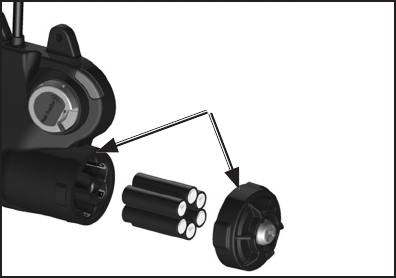
Page 24 of 28
P/N 595277-01 Rev E 10/17
CHECK YOUR WORK!
BEFORE ASSEMBLY OF BATTERY COVER,
CHECK TO SEE ALL BATTERIES ARE FRESH,
NEW BATTERIES OF THE TYPE INDICATED
ABOVE AND THAT THEY HAVE BEEN INSTALLED
PROPERLY.
FIGURE 7
BE SURE SEALING
SURFACES ARE CLEAN
BEFORE REASSEMBLY
6. The battery cover must be installed so that it is water tight after replace-
ment. Clean the sealing rib around battery compartment and sealing face
of the cover, shown in FIGURE 7, by wiping with a clean damp cloth to
remove any dirt or foreign matter which might prevent a proper seal. Check
cover gasket for tears or cuts. If damage is found, remove respirator from
service and tag for repair by authorized personnel.
7. To install battery cover, align the three grooves on the cover with the three
tabs on the battery compartment and tighten the cover screw. The cover
must be water tight to prevent damage to the equipment.
8. To test the batteries, verify that the PAK-ALERT distress alarm is in the off
condition (cylinder valve closed with no ashing green LED on the control
console).
a) Press and hold the reset button on the console. A GREEN light on the
console indicates sufcient battery power and that the batteries are
properly installed.
b) If the unit displays the LOW BATTERY condition or no light at all, verify
that the batteries are properly installed. If the batteries were properly
installed, remove the batteries and replace with a new set of six (6)
batteries.
c) If another set of properly installed batteries will still not produce a
GREEN light on the battery test, remove the unit from service and mark
for repair by authorized personnel.
AFTER REPLACEMENT OF BATTERIES, PERFORM A REGULAR
OPERATIONAL INSPECTION BEFORE RETURNING RESPIRATOR TO
SERVICE.
CAUTION
IMPROPER BATTERY COVER INSTALLATION
CAN CAUSE BATTERIES TO OVERHEAT AND
MAY CAUSE DAMAGE TO THE PRODUCT.
ALWAYS MAKE SURE THAT THE ALIGNMENT
GROOVES ON THE BATTERY COVER ARE
ALIGNED WITH THE TABS ON THE BATTERY
COMPARTMENT DURING INSTALLATION OF
THE COVER.
DRAFT
NOT FOR DISTRIBUTION

Page 25 of 28 P/N 595277-01 Rev E 10/17
PAK-ALERT DISTRESS ALARM PERFORMANCE SPECIFI-
CATIONS
Sound Levels:
Pre-Alarm... ......................... 80 to 105 dBA incrementally at left ear
Full-Alarm ............................ 95 to 100 dBA @ 9.9 Ft. (3m)
Frequency Range ............... 1.5 KHz to 4 KHz
Battery Life (fresh batteries)
Alkaline Batteries:
Automatic (green ashing light, no sound) ..............Approx. 1000 hours
Full Alarm (red ashing light, 95 dBA sound)....... .Approx. 8 hours
Compliance
The SCOTT PAK-ALERT distress alarm is a NIOSH approved accessory
for use only on approved SCOTT X3 AIR-PAK respirators.
NOTE
DO NOT USE A FIBERGLASS WRAPPED ONE HOUR CYLINDER ON A
MODEL 4.5 AIR-PAK EQUIPPED WITH A PAK-ALERT DISTRESS ALARM AS
THE WEIGHT WILL EXCEED THE 35 LBS APPROVAL LIMIT FOR SCBA’s
ESTABLISHED BY NIOSH.
If this PASS distress alarm is being used as part of a complete NFPA
1981, 2013 edition compliant respirator assembly, report any operational
malfunctions to the certication agency Safety Equipment Institute (SEI),
1307 Dolley Madison Blvd. Suite 3A, McLean, VA 22101, (703) 442-5732,
Fax (703) 442-5756.
QUESTIONS OR CONCERNS
If you have any questions or concerns regarding use of this equipment or if
you need additional copies of this or related User Instructions, contact your
authorized SCOTT distributor, or contact SCOTT at 1-800-247-7257 (or 704-
291-8300 outside the continental United States) or visit our web site at www.
scottsafety.com.
DRAFT
NOT FOR DISTRIBUTION

Page 26 of 28
P/N 595277-01 Rev E 10/17
NOTES
DRAFT
NOT FOR DISTRIBUTION

Page 27 of 28 P/N 595277-01 Rev E 10/17
NOTES
DRAFT
NOT FOR DISTRIBUTION

Page 28 of 28
P/N 595277-01 Rev E 10/17
Scott Safety
4320 Goldmine Road
Monroe, NC 28110 USA
Telephone 1-800-247-7257
Fax (704) 291-8330
www.scottsafety.com
Printed in USA
NOTICE:
THESE USER INSTRUCTIONS
ARE TO BE REMOVED ONLY
BY THE END USER.
DRAFT
NOT FOR DISTRIBUTION